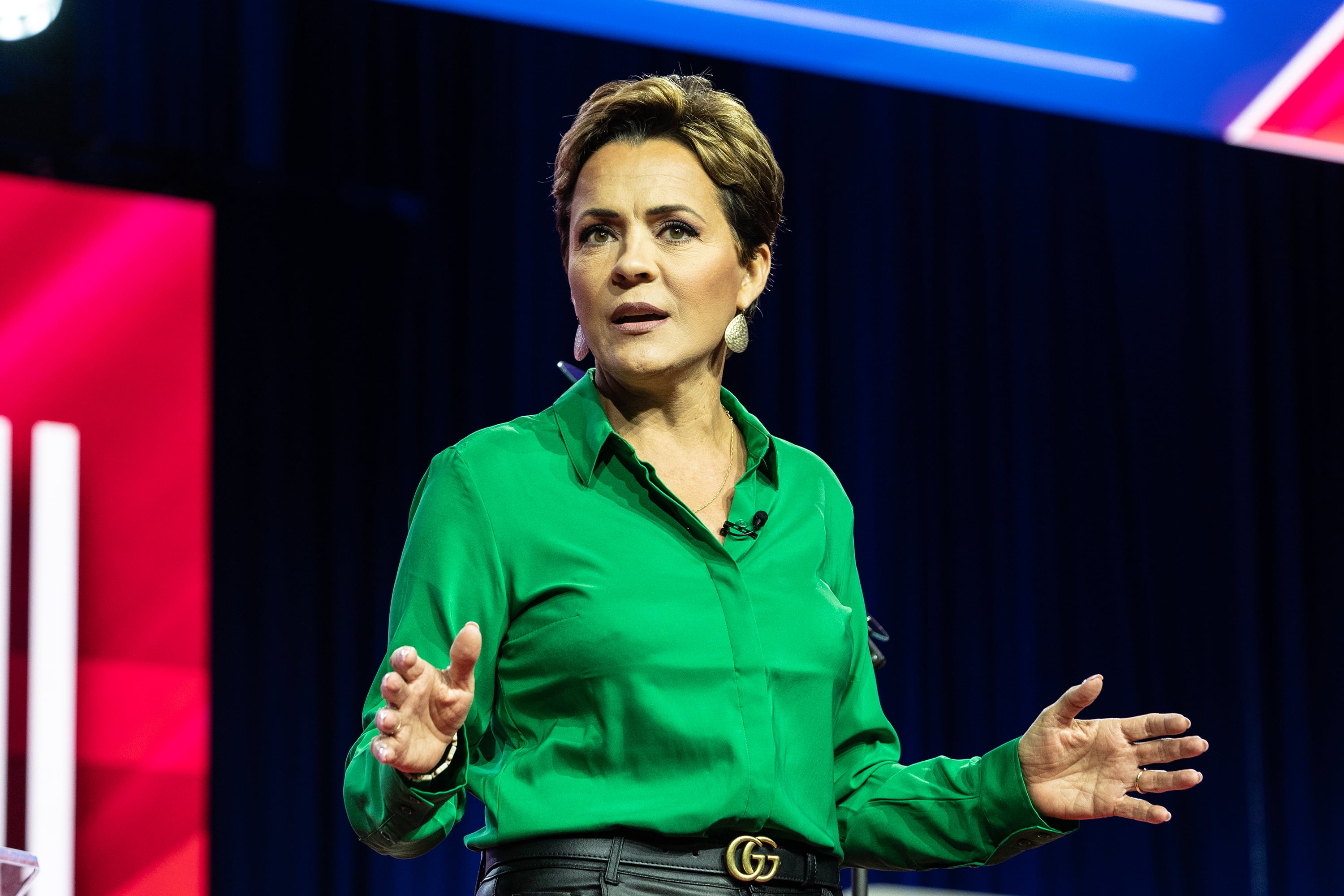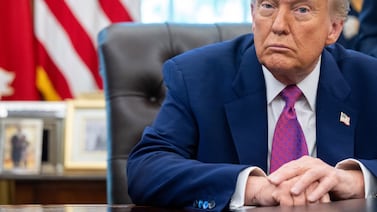Votebeat Arizona is a nonprofit newsroom reporting on voting access and election administration in Arizona. Dig deeper into how your vote gets counted in our free newsletter.
A Maricopa County judge may soon allow Kari Lake to attempt to prove one of the most far-fetched claims she made in her lawsuit challenging her November loss against Gov. Katie Hobbs: That bad actors forged signatures on tens of thousands of mail-in ballot envelopes, and the county failed to follow state law when approving them.
Lake’s claim, which the Arizona Supreme Court remanded to the trial court last week, is the losing GOP gubernatorial candidate’s last chance to prove her election should be overturned. She has spent the last several months on a money-making media tour based on the false assertion that she actually won the election. But the claim is supported so far only with anecdotes, and she faces many substantial hurdles in convincing a judge she has any proof.
Much of her theory has so far rested on how Maricopa County verified voter signatures in 2020, not 2022, and on an outside analysis done as part of Republican senators’ review of the 2020 election. “Maricopa County election officials allowed tens of thousands of ballots with signature mismatches like this one to be counted in 2020,” she wrote in her initial complaint, showing a signature comparison from 2020. She then added, vaguely: “They did the same thing in the 2022 general election.”
Knowing this process would be harshly scrutinized — as it was after 2020 — Maricopa County Recorder Stephen Richer, also a Republican, tried to improve it in the period leading up to the midterms in ways that haven’t been previously reported. He increased training for workers who review signatures, increased the signatures the workers had to compare, added an audit step for approved signatures, and increased the number of people doing the work, according to a Votebeat review of county documents and data.
“It’s a human process, so we added more controls and more checks,” Richer said.
These changes may be what led the county to reject so many more ballots for bad or missing signatures in 2022. The county rejected 3,099 ballots for bad or no signatures in 2022, or .24%, compared to .11% in 2020 and .18% in 2018, according to county data. The number of bad signatures rejected more than doubled, from 587 to 1800.
The Supreme Court decision said that Lake will need to prove, first, that Maricopa County didn’t follow the state’s law for reviewing signatures. That’s hard to do when the law requiring counties to review signatures doesn’t detail how exactly signatures must be reviewed, other than to say workers must compare the signatures with other signatures they have on file.
Second, Lake will have to prove that this lapse in process led to so many fraudulent signatures being accepted that it would have changed the outcome of the election, which Hobbs won by more than 17,000 votes. To prove that to the court, Lake would need to find tens of thousands of potentially fraudulent signatures, according to a formula set up by the court.
Richer said he is confident that Lake’s claim will be dismissed, as have more than 20 other lawsuits regarding the 2020 and 2022 elections.
“This case will be no different, and will simply add another mark to Lake’s impressively long losing streak,” Richer said in a statement after the Supreme Court decision.
The case may turn on how Richer has tried to improve the signature review process since 2020.
Tried to improve training for signature review workers
The ability of temporary election workers to accurately verify hundreds of thousands of voter signatures has been widely disputed. Outside of the elections world, signature verification — in criminal cases or the like — is typically left to forensic experts with extensive training, who might spend hours studying one signature alone.
That’s part of why there’s other backstops in place to prevent mail-in voting fraud including, in Maricopa County, a barcode on the ballot envelope that ensures each voter receives just one ballot, and that the county accepts just one ballot from each voter.
Still, the state uses the signatures as a way to confirm the voter’s identity, since mail-in voters aren’t present at a voting location to show their ID, as is required for people who vote at the polls.
Arizona law doesn’t require any specific training for workers doing the work.
The statute and Elections Procedures Manual say county officials must compare the voters’ signatures with other signatures they have on file, such as from when the person registered to vote or other times they have signed ballot envelopes. It doesn’t say much more about the method that workers must use to confirm the signature is valid.
To try to improve training, Richer this year required all managers to go to a four-hour training hosted by the state led by a private company, Associated Forensic Laboratory, that specializes in forensic training. Prior to this, Richer said, managers didn’t have to go if they had already been once before. Other workers are also trained, according to elections staff.
The training is offered to all 15 counties, according to secretary of state’s office spokesperson Paul Smith-Leonard, and instructs workers on the characteristics of valid and fake signatures and how a signature may or may not change as someone ages.
Richer also ensured this year that his team was using a comprehensive guide produced by the state in July 2020 for how to review signatures.
Removed any computer-sorting of voter signatures
After 2020, a technology that the county had been using to sort out potentially blank signatures was criticized, with Trump supporters claiming that the county was using artificial intelligence to verify signatures. That was false, as all signatures were ultimately verified by humans.
The technology, called Verus Pro, is offered by Runbeck Election Services, which processes mail-in ballots for the county. Richer decided to turn off Verus Pro for the 2022 elections.
“With all the hoopla made about it and not wanting to muddy the waters, we removed that,” Richer said.
More signatures and an added an audit step
Maricopa County has always had a multi-tier process for approving signatures. Richer added more details and steps.
The initial reviewer now has three signatures on file to compare with the voter signature on the envelope, instead of one. This was to give “a higher level of confidence on the initial conclusion,” Richer said.
If that initial reviewer doesn’t believe the signature matches those on file, it goes to a manager, who has access to all of the voter’s signatures on file. If the manager rejects it, that’s when the county reaches out to the voter to attempt to verify it’s their ballot.
Under state law, the county must try to reach a voter before rejecting their bad or blank signature, and a voter has five days after the election to verify their signature.
Richer also added another step to the review process, which he calls an “audit queue.” If the first-level reviewer accepts the signature, it no longer is accepted outright. It goes into the queue, and for every 10,000 approved signatures, a randomized sample of 2% of those are selected for additional review.
Hired more staff, reduced the pressure on speed
To reduce the pressure on workers, Richer hired more temporary staff to do the work full-time, and encouraged his permanent staff to help out as often as they could.
The county had 29 temporary staff and four permanent staff on the job in 2020, compared to 41 temporary staff in 2022, even though turnout was significantly higher in 2020. Both times, additional workers helped out when they had time. Richer said he reviewed thousands of signatures himself in November.
Richer also tried not to put pressure on workers to move quickly, he said.
“The messaging from my office has consistently been, do what you need to do to feel comfortable,” he said. “They aren’t given a quota. They aren’t paid on number of signatures verified.”
Overall, workers marked 18,510 signatures as “non-matching,” and of those, 15,411 voters confirmed it was their ballot, or “cured” their ballot. That led to 3,099 rejected for bad or missing signatures. Of those, 1,299 were missing signatures and 1,800 were bad.
Richer said all his changes were made to ensure workers were “being extra thorough, rather than just moving ballot packets forward.”
But he again re-emphasized that signature verification is just the last step in confirming a voter’s identity, not the only step. And to the claims that a significant number of people are trying to commit early voting fraud, or that a significant number of ballots have been stolen in the mail, he said there is no evidence.
Jen Fifield is a reporter for Votebeat based in Arizona. Contact Jen at jfifield@votebeat.org.






